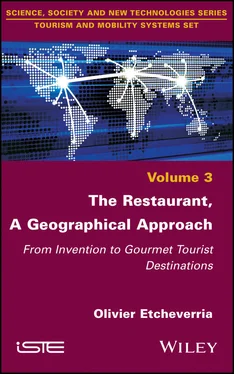She thus insists on the complementary professional activity of communication and publications of Mathurin Roze de Chantoiseau, who published in 1769 Almanach général d’indication d’adresse personnelle et domicile fixe de Six Corps, Arts et Métiers 2 . François-Régis Gaudry specifies:
“This directory listed, in alphabetical order, several thousand merchants, traders, craftsmen and entrepreneurs who each demonstrated talent and initiative in their own field […] Similarly, a supplement to the almanac listing the new caterers indicated ‘Roze, the First Restaurateur’. Smart and intuitive, Mathurin Roze de Chantoiseau was actually intelligent enough to play on two sides to support his business: he was Chantoiseau the author-publisher on the one hand, and Roze the restaurateur, on the other. Since 1766, the restaurant was located in the Hôtel d’Aligre, rue Saint-Honoré, at the same address as its publishing house.” [GAU 06, pp. 21–22]
In addition, Rebecca L. Spang points out that: “Like any number of these enterprising authors and would-be reformers, Roze de Chantoiseau frequented the aristocratic and administrative circles in Paris.” [SPA 00, p. 15]
But who was the first restaurateur then? Boulanger or Roze de Chantoiseau? An answer is provided by François-Régis Gaudry:
“The famous Boulanger consigned to the dungeons of history and Mathurin Roze de Chantoiseau suddenly presented as the undisputed inventor of the restaurant? Not so sure, because it may be that the two people are actually only one. Indeed, in several texts of the time, Boulanger was also called ‘Champ d’Oiseau’, a nickname strangely close to ‘Chantoiseau’.” [GAU 06, p. 21, author’s translation]
Eugène Briffault, for his part, attributes Lamy as the first creator of the restaurant: “The first restaurateur in Paris was a man named Lamy. He opened his private rooms in one of the dark and narrow passages that surrounded the Palais-Royal at the time.” [BRI 03, p. 91, author’s translation]. In Le mangeur du XIXe siècle , Jean-Paul Aron confirms: “The first authentic restaurateur, Lamy, served very ordinary dishes around 1773.” [ARO 89, p. 19, author’s translation]
Rebecca L. Spang also mentions the opening of an establishment run by the restaurateur Minet:
“In March 1767, L’Avantcoureur (The Forerunner), a journal dedicated to innovation in the arts, the sciences, and ‘any other field that makes life more agreeable,’ announced that a new type of establishment had opened in Paris’s rue des Poulies. The new business specialized in ‘excellent consommés or restaurants always carefully warmed in a hot water bath.’ These restaurants were available at all hours, at reasonable prices, and were served in gold-rimmed, white faience dishes.” [SPA 00, p. 34]
The restaurant is an expressive form of Parisian elite social demand for dietetics and taste:
“As much a scientific innovation as a culinary curiosity, the opening of the first restaurant responded to the 18th Century elite culture’s preoccupations with the pursuit of health as well as its fascination with cuisine.” [SPA 00, p. 26]
François-Régis Gaudry insists on this dietary interest by pointing out that Mathurin Roze de Chantoiseau first named his restaurant the “ Maison de santé ” (literally meaning the health home):
“This name, which came to disappear a few years later, betrayed the medical mission of the first restaurants. Roze prepared, for the attention of the urban elite who suffered from vapours, miasmas and bronchial weaknesses, ‘reconstituting bouillons’ which he served in small cups. These consumers drew their success from their nutritious and digestible properties because they knew how to capture the rich flavor of meat and vegetables while presenting them in a liquid form.” [GAU 06, p. 22, author’s translation]
The restaurateur Minet offered fresh eggs, fine butter, jellies and “cream of rice and gruel from Brittany with fat and milk”. The restaurateur Vacossin, rue de Grenelle, served cream cheese, fruit, semolina, Palais-Royal biscuits, capons with coarse salt and “lunches with fine herbs” 3 . In the first restaurants, it was also possible to eat rice or vermicelli soups, macaroni, fruit purées, etc. According to Rebecca L. Spang, the craze for these “healthy” dishes was linked to a sociocultural context under Rousseauist influence:
“Rousseau’s sensitive characters inhabited a milk-and-honey world of (comparatively expensive) fruits and dairy products. When restaurants served ‘simple’ bouillons, they similary contributed to the construction of a mythical version of sincere, healthful country life which proved acceptable to an urban, elite population.” [SPA 00, p. 42]
It is an urban cult of sensitivity:
“As an emotional or intellectual state with physical manifestations, the cult of sensibility also conjured up its own spaces: the farm where Marie Antoinette played milkmaid, Rousseau’s grave, and the restaurant. The restaurant introduced Rousseau’s desires – not just the paradoxically refined simplicity of his ideal meals, but the equally perplexing publicity of his privacy – into the marketplace.” [SPA 00, p. 63]
Thus, since their invention, restaurants, these urban places, mainly frequented by urban diners, have produced and disseminated discourses and, even more so, gastronomic images of the countryside and nature.
In this Parisian, urban, sensory context, the restaurant was originally both a public and a private place where consumption and tasting practices took place:
“The restaurant was a publicly private place: Minet promised the weak-chested ‘a public place where they can go to take their consommé’, but (and in no less certain terms) another restaurateur advertised his establishment as perfectly suited to ‘those who would hardly want to eat in public’. Neither expansively ‘public’ nor narrowly ‘private’, the restaurant offered the possibility for a public display of private self-absorption.” [SPA 00, pp. 86–87]
Lounges and staff met this need for privacy and even confidentiality.
Therefore, the restaurant initially demonstrated original properties. It was frequented by urban diners who were looking for quality products, sometimes rare or even luxurious, rigorously chosen, skillfully cooked and carefully served. François-Régis Gaudry underlined the diversity of restaurant customers:
“The restaurant welcomed a heterogeneous clientele: merchants, intellectuals, aristocrats, actors, financiers, officers… But the greatest sociological innovation lied in the appearance of women, seduced by the delicacy of the dishes and the intimacy of the private rooms.” [GAU 06, p. 25, author’s translation]
According to Eugène Briffault:
“The establishment of the restaurateurs was a social fact. Under the regime in which they succeeded, good food was the privilege of opulence; the restaurateurs made it accessible to everyone. A man who could, once in his life, spend twenty or twenty-five francs on his dinner, if he knew how to choose his dishes, and if he sat at the table of a first-rate restaurateur, was treated better than if he dined with a prince: he was served with as much splendour as in a palace; he ordered at will; his taste and desire knew no boundaries; free from all consideration, he obeyed only the whims of his fantasy and his delicacy. Restaurateurs therefore took a great step forward in social equality, established by the community of enjoyment much more than by theories that would never succeed in placing the poor on an equal footing with the rich.” [BRI 03, pp. 92–93, author’s translation]
In a prepared, comfortable, peaceful and clean room, diners enjoyed their varied dishes set up at individual tables and, most often, tablecloths 4 . “They thus avoided promiscuity and could make confidential or courteous comments”, emphasized Jean-Robert Pitte [PIT 91, p. 159, author’s translation]. It was even possible to choose your table. The richness of restaurant decorations was significant.
Читать дальше












